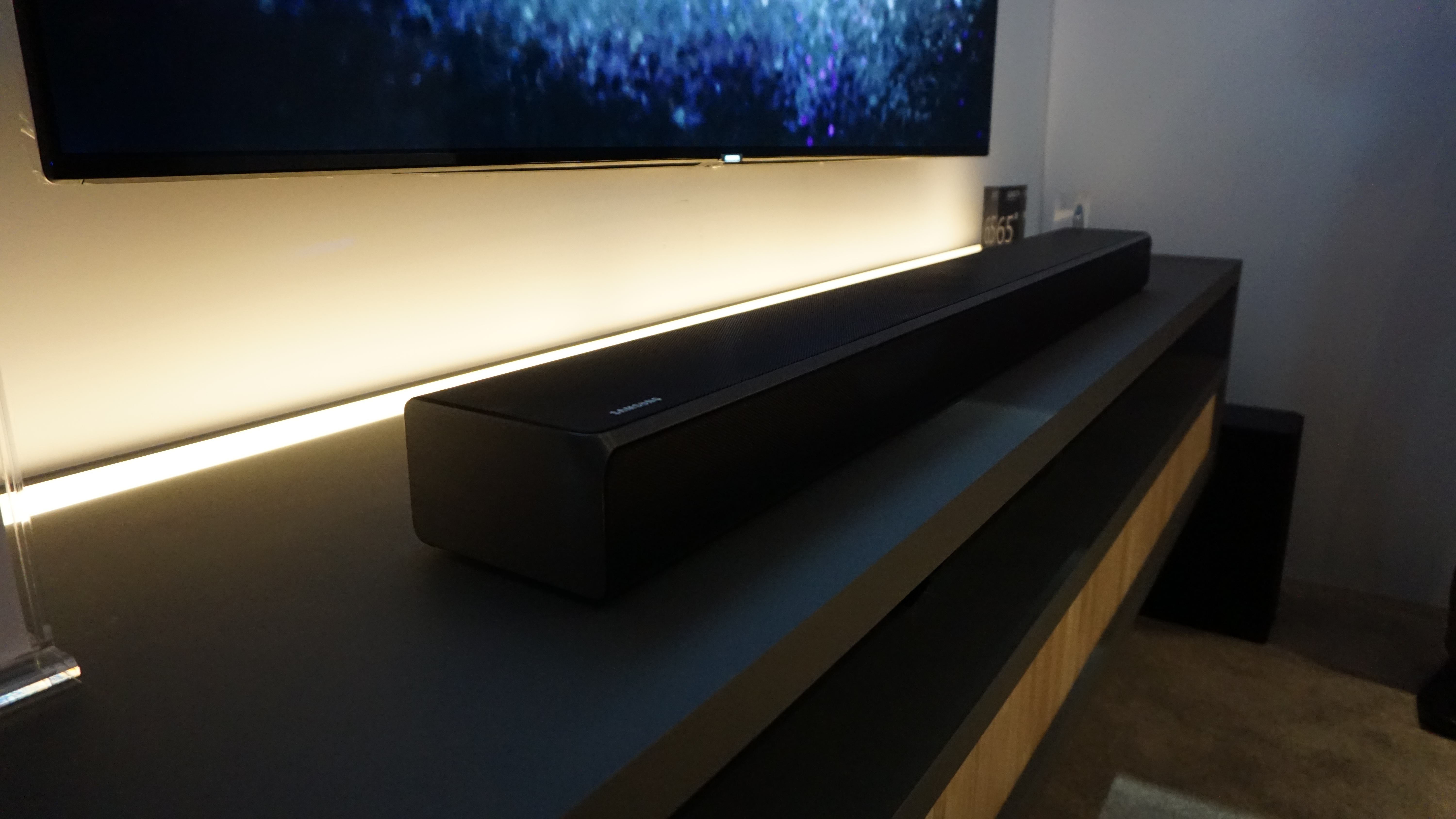TechRadar Verdict
The K950 is a real flag waver for Samsung's audio division. It's been designed and built completely in house, working closely with Dolby's engineers to perfect the Atmos capabilities - and the results are more spectacular than any sound bar we've heard before.
Pros
- +
Incredible sound quality
- +
Dolby Atmos support
- +
4K passthrough
- +
Good value
Cons
- -
Only stereo DTS support
- -
Needs specific room setup
- -
Needs the right sources
- -
Expensive vs non-Atmos products
Why you can trust TechRadar
Anyone who's experienced Dolby Atmos sound at the cinema will know that it rocks. The addition of height channels to a surround sound mix takes your sense of immersion in a movie's world to a phenomenal new level.
You can now get Dolby Atmos at home too, of course – and it's growing in importance now that Atmos tracks seem to be arriving almost by default on the latest Ultra HD Blu-ray releases.
There's usually a catch with embracing Atmos at home, though: either you need to somehow fill your room with speakers – including fitting some into the ceiling – or else you have to make do with a compromised system that strives to deliver an Atmos effect by carefully angling multiple drivers from a much reduced number of speakers.
Here, though, we're looking at a new domestic solution to the 'Atmos problem' that solves it better than any other 'convenience' system released to date. In fact, despite its rather prosaic HW-K950 name, I'd say Samsung's ingenious new Atmos solution (designed and built in Samsung's high-tech new audio facility in California) is simply the best soundbar we've heard, so much so that calling it a mere soundbar feels like an injustice.
Speaker setup
Let's look first at what the K950 package consists of. The 'main event' is a surprisingly traditional-looking (considering what it does) black bar that's designed to sit under your TV; an optional wall mount system is available if you've hung your TV up.
The bar is joined by a fairly large wireless subwoofer and a pair of conventionally sized – but again wireless – rear speakers.
The system is not, in truth, especially easy on the eye compared with some of today's soundbar and multi-channel speaker packages. But the design takes on technical marvel status when you realise what each unit's got crammed inside.
Sign up for breaking news, reviews, opinion, top tech deals, and more.
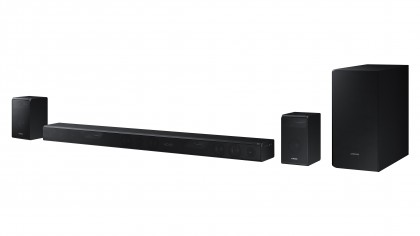
The K950's driver system is designed in a 5.1.4 configuration, which translates into five channels in the main soundbar, one bass channel from the subwoofer, and four channels from the two rear speakers. As is necessary for any Atmos system, the sound produced by the K950 includes front and rear height channels, delivered by top-mounted drivers firing up at just the right angle to create the 'sphere of sound' that's an Atmos trademark.
Talking of drivers, remarkably for its £1,300 ($1,799, about AU$2,399) price the K950 system carries no less than 16 of them, each with its own dedicated amplifier (total amplification is 500W). That breaks down as three 1.2-inch tweeters, six 2.5-inch mid-range drivers and two 3-inch full-range drivers in the sound bar, four 3-inch full-range drivers in the surrounds, plus the 8-inch bass driver in the subwoofer.
Well-connected
The K950 also stands out from the pack with its connections, as it's the first Atmos-capable soundbar to support 4K pass-through via HDMI. So you can attach 4K sources such as Ultra HD Blu-ray players, the Xbox One S, and a cable box to its two HDMI inputs, and have the Ultra HD (and high dynamic range if available) picture part of the feed passed on to your 4K TV via the K950's HDMI output while the K950 deals with the audio.
It's a pity, perhaps, that the AV pass-through feature only works when the soundbar is switched on. But if you've spent big bucks on an audio system like the K950 you'll probably want to get as much use out of it as possible.
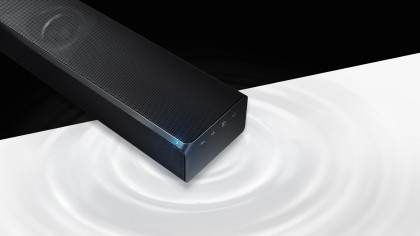
Aside from the key HDMIs, the K950's other connections comprise an optical digital audio input and a 3.5mm analogue audio input, plus Bluetooth and Wi-Fi network connectivity.
The network options, in conjunction with Samsung's smartphone app, mean you can stream music into the K950 from a wide range of online sources, including TIDAL, Amazon Music, Spotify, TuneIn Radio, Deezer, Napster and – since the system can play back high-resolution audio formats – the '7 digital' website.
If you'd rather look closer to home for your music sources you can use DLNA to stream music stored on your PCs and NAS drivers. Plus the Bluetooth can be used for wirelessly sending sound from compatible Samsung TVs to the K950.
Domestic Dolby Atmos systems usually require you to sit in a quite specific 'sweet spot' to get the optimum listening experience. For the K950 series, though, Samsung has used specially designed dome-style tweeters to expand the sweet spot area to a degree where, it's claimed, a family of three or four should be able to sit in a row on the sofa and still experience pretty much the same level of audio immersion.

This is a great touch for sure, although there are still some quite specific room conditions you'll need to satisfy if you really want the system to sing – more on this in the Usability section of this review.
The K950 offers a decent selection of sound presets for different types of music, and supports Dolby Digital 5.1 and 7.1 mixes as well as Atmos ones. It even carries processing that can create an Atmos 'sound sphere' effect from non-Atmos sources.
Blu-ray limitations
There is one thing the K950 does not do, however, and that's play DTS soundtracks in anything more than stereo. Samsung has opted to do this in order to keep licensing costs down, and to ensure that the K950 produces an absolutely uncompromised performance with Atmos tracks. But it's clearly a significant limitation when you consider how many Blu-rays only carry DTS soundtracks for their main English language mixes.
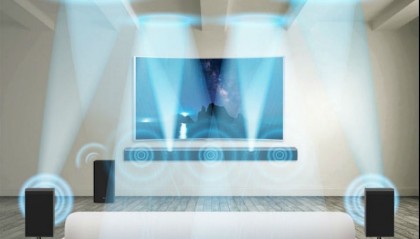
A quick rummage through the 20 most recent Blu-rays I've bought reveals that no less than 17 of them use DTS Master Audio for their main English language tracks. Assuming this is representative of the wider Blu-ray world, that means more than 75% of Blu-rays you already own or intend to buy may only play in stereo on the K950. And while the K950 does provide a processing option that attempts to turn these stereo feeds into surround sound, it inevitably doesn't work too well (as we'll discuss in the Performance section).
Fortunately, there is a solution of sorts to the DTS problem. The thing is, some Blu-ray players carry re-encoding systems that can convert DTS to Dolby Digital 'on the fly'. So if you want to get surround sound from a DTS soundtrack you can go into one of these player's menus and switch the re-encoding to Dolby Digital on.
Apparently, all of Samsung's Blu-ray players for the past three years have carried this re-encoding feature, as does Samsung's K8500 Ultra HD Blu-ray player. It seems some Sony players support it too. The problem is that it's not possible to provide a comprehensive list of every Blu-ray player that supports DTS to Dolby Digital conversion; and so far as we can tell, no Panasonic Blu-ray players – not even, sadly, the brand's high-end UB900 Ultra HD Blu-ray player – support the feature.
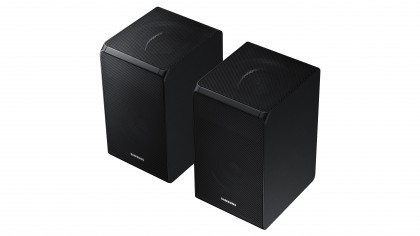
Even if you have or buy a suitable Blu-ray player, if you switch DTS-to-Dolby Digital re-encoding on for a DTS Master Audio Blu-ray, you need to remember to go back into your player's menus and switch the audio output back to 'Unprocessed bitstream' when you want to play a film with a Dolby Atmos track.
One bit of good news in all this is that Dolby Atmos tracks are starting to appear on pretty much all the latest Ultra HD (rather than standard HD) Blu-ray discs, so unless the DTS:X equivalent format suddenly starts to make a comeback, the K950 is looking well set to provide stunning audio company for the next generation of AV sources.

John has been writing about home entertainment technology for more than two decades - an especially impressive feat considering he still claims to only be 35 years old (yeah, right). In that time he’s reviewed hundreds if not thousands of TVs, projectors and speakers, and spent frankly far too long sitting by himself in a dark room.
